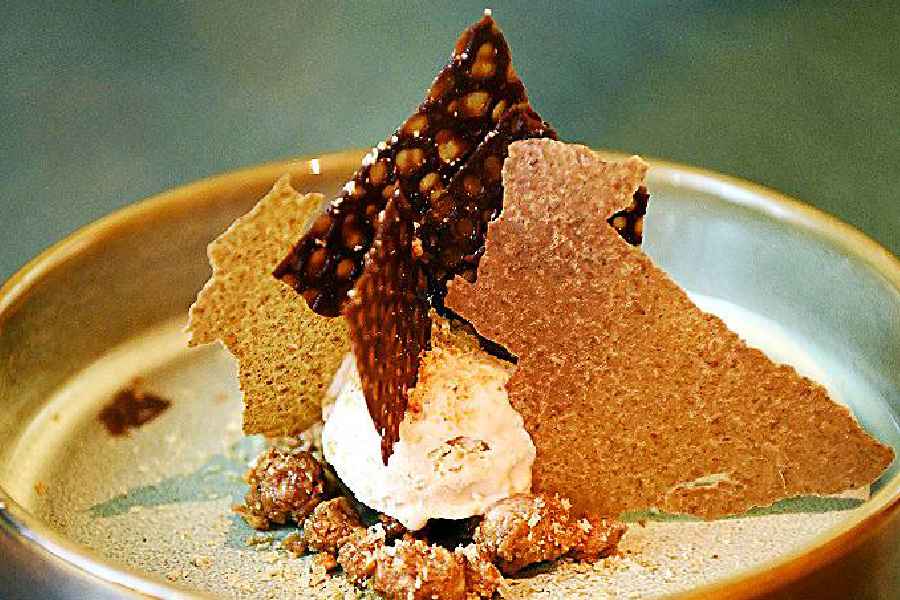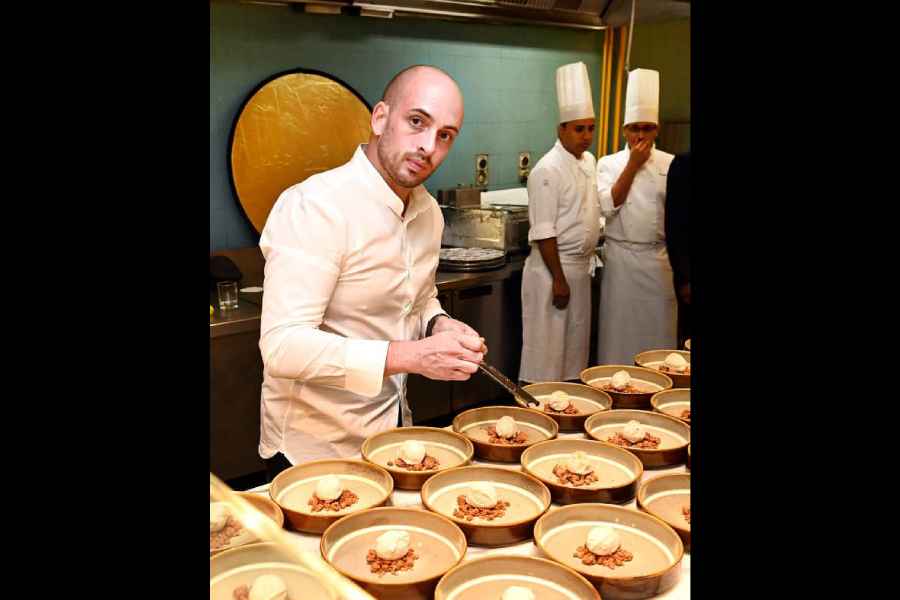Maxime Gilbert, founder of Hong Kong’s famous French-Japanese dine den Ecriture, was in town for a special night of fine food at Taj Bengal’s Chambers Rendezvous on August 12. The Michelin-starred chef showcased his unique style of cooking with Japanese produce using French techniques. t2 sat down for a chat and a menu tasting. Excerpts and snapshots...
Is this your first time in India? Tell us about your perceptions regarding Indian food?

(L-R) Arnab Chatterjee, hotel manager, Taj Bengal; chef Maxime Gilbert; Nitin Mathur, executive chef, Taj Bengal; and K. Mohanchandran, senior vice president, East and North East, IHCL
I love Indian food, although I don’t know much about it because the names are too long. Even in Hong Kong, I always order too much and end up eating too much as well (laughs). My favourite food in the world is bread and it’s my guilty pleasure. Indian breads are different from French ones and I really love them. The last time I was in India, I had tried the dosa. And now every time I’m here, I order it for breakfast. What I really love is the culture and the history that Indian cuisine has. Many people tend to forget that apart from Europe, there are many countries that have an extremely widespread and rich culinary heritage as well. Maybe we (France) brought out fine dining to the world, but it’s not just limited to us. I’ve been travelling recently to many countries — Morocco, China, USA — and you can’t compare one to the other. One thing that I’ve learnt about Indian food is that the sauce/gravy is of extreme importance. It’s the same case with French cuisine. The sauce brings in all the flavours together, and now more and more chefs are focussing on it. Chefs had somewhere down the line become obsessed with presentation and beauty, but now it’s all about the sauce. It’s a big part of my cuisine. In India, you have so many important sauces as well.
How would you describe your food philosophy?
Ummm… so now I’m 40. Right after my studies, I started travelling, to the US, then to France, Morocco, China and Hong Kong, and so my tongue and flavour changed. I’ve become lighter. My way of cooking has changed. Earlier I was drawing dishes first, trying to make it look more and more visually appealing. But now, I focus more on the harmony of flavours. This process was tough. My dishes are now clear and straightforward. I edit a lot. But my cuisine has a lot of prep. Even though the dishes are straightforward, the elements require meticulous preparation. My food is all about different layers. It’s like wine. For a layperson, a glass of good wine is just a good wine, but if you’re a connoisseur, you can understand the different layers of flavour notes.
One thing that I personally don’t like is when people visit fine-dining restaurants and the servers explain to people that the chef would like for them to eat the dish in a certain way. I feel that the diner needs to eat it according to their preference, without the extra faff and hassle. I don’t like bothering the customer. I don’t like it when they explain too much to the customer.
The cuisine that you specialise in is pretty distinct in the sense that it amalgamates two great cuisines. How did you stumble upon your style?
My base is very French. But I’ve been in Asia for really long. I fell in love with Japanese produce. One of the reasons why I became a chef was the variety of produce. Hong Kong is a complicated market. The demand is not for local but for exotic and high-quality stuff. It’s not about sustainability, even though I would like for it to be sustainable. So I combined the best bits of Japanese and French cuisine. Both countries have a great history of gastronomy. I work with the produce from both countries. Travelling has helped me sharpen my technique and flavour profile. My food is lighter now. I don’t believe in giving people a food coma.
The famed Michelin-star restaurants are not strangers to you. What was that experience like?
As chefs, we always want the Michelin star. It drove me since I was a kid. I always wanted to have three stars. But now I’ve realised that you don’t work for the stars. You work for your customers. The Michelin inspectors come in, eat and decide. There are no rules, but at the end of the day, we all decide to play the game. You need to do confident and focused work and make decisions that are best for the business and the customer. It’s not standard like a five-star hotel. The demand in Hong Kong isn’t the same as in the rest of the world, there are only certain few restaurants that were in demand, so we have done a lot of restructuring and rethinking to cater to the demands of the audience.
You’ve worked with some celebrated chefs in your career. Who’s one of your biggest mentors and why?
For me it’s been Yannick Alleno. I started working with him in Paris when I was just 21 years old. We’re always in touch and we talk a lot. In fact, recently I did a charity event for him in March. It was a tragic thing, he lost his son, and for a certain cause related to it, we did a charity event.

Zucchini Tart
What would a typical meal made by Maxime look like?
That totally depends on the season. For example, for this Chambers Rendezvous event, the menu has some specials such as one dish that I created for people to share, it was in fact a Valentine’s Day special with produce that people love, the Caviar Tart. It’s now become a part of the menu. When I travel for events and pop-ups I try and recreate some of my bestselling dishes with the produce available at hand in the region. In a way, this dish saved us during Covid as we were doing takeaways and sold so many of these. There is also a lamb dish, but of course, the lamb isn’t the same as we use in Hong Kong. I’ve replaced sea urchins with scallops in the first course.
Apart from French-Japanese, what are some of the cuisines that fascinate you?

Lamb Loin and Shoulder with Bigornaux Lemon Sabayon
All. I love everything. I’m always travelling and every time I’m in a new place I love to try the new stuff available. I love the variety of textures in Asian cuisine. It’s chewy, crispy, and full of flavour. In fact, the different types of soups also have distinct flavours. It can be thick and gelatinous also with crunchy elements.
If you could feed three famous people, living or dead, who would you feed and what?
I don’t know. Hahaha. I’m not someone who’s a celebrity-crazy person. I don’t follow soccer. In fact, if I see someone like Messi sitting here, I would just casually pass by. All chefs are very important to me. Ecriture is the first restaurant that I’ve worked in that’s not inside a hotel, all the past ones have been and we’ve seen many celebrities pass by, and if there are special people present, you’ll have to give them that kind of treatment. For me the people that I would love to feed would be chefs who walk in to try my food, my regular patrons who come in for meals, people who really want to try my food, save up for it as a celebratory occasion, those are the kind of people I’m excited to cook for and offer special complimentary dishes as well. I always give them special prices and add extra courses.

Madeleine Salted Caramel
I’ve had the chance of receiving that treatment myself, so now I want to extend it out. So for me, people in F&B are more important than celebrities. Sometimes when people don’t order expensive wines, they’re looked down upon, but I feel that not everyone can afford a 1,000 Euro bottle and not everyone wants to drink, so why the snide remarks? You can’t judge people by that. I’m happy to see people coming in to experiment with my food.

(l-r) Eggplant with Confit and Glaze with Miso Lemon Sabayon, Caviar Tart
The single diner is also someone I really look up to. I can’t go and have a meal by myself. In Paris, on New Year’s Eve once we have a single diner and we make sure we gave him the best because I feel that those celebrating a major festival alone need that slight bit of extra comforting treatment. Not just men, we also see a lot of female solo diners and it is to those people that I love to extend some extra courses and special prices. You also get to meet and know people this way.
What are some of the ingredients that you’re most comfortable working with?
Butter, and Fleur de sel because it has the flavour of the sea without being extra salty.
